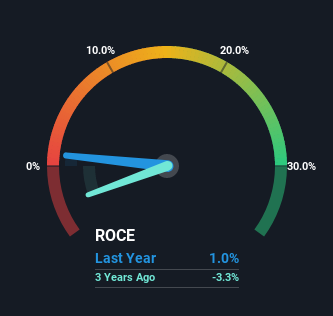- Malaysia
- /
- Electrical
- /
- KLSE:TAWIN
Returns On Capital Signal Tricky Times Ahead For Ta Win Holdings Berhad (KLSE:TAWIN)
Did you know there are some financial metrics that can provide clues of a potential multi-bagger? Ideally, a business will show two trends; firstly a growing return on capital employed (ROCE) and secondly, an increasing amount of capital employed. Basically this means that a company has profitable initiatives that it can continue to reinvest in, which is a trait of a compounding machine. Having said that, from a first glance at Ta Win Holdings Berhad (KLSE:TAWIN) we aren't jumping out of our chairs at how returns are trending, but let's have a deeper look.
What Is Return On Capital Employed (ROCE)?
For those that aren't sure what ROCE is, it measures the amount of pre-tax profits a company can generate from the capital employed in its business. To calculate this metric for Ta Win Holdings Berhad, this is the formula:
Return on Capital Employed = Earnings Before Interest and Tax (EBIT) ÷ (Total Assets - Current Liabilities)
0.01 = RM3.2m ÷ (RM443m - RM119m) (Based on the trailing twelve months to March 2022).
So, Ta Win Holdings Berhad has an ROCE of 1.0%. Ultimately, that's a low return and it under-performs the Electrical industry average of 8.0%.
See our latest analysis for Ta Win Holdings Berhad

Historical performance is a great place to start when researching a stock so above you can see the gauge for Ta Win Holdings Berhad's ROCE against it's prior returns. If you're interested in investigating Ta Win Holdings Berhad's past further, check out this free graph of past earnings, revenue and cash flow.
What Can We Tell From Ta Win Holdings Berhad's ROCE Trend?
On the surface, the trend of ROCE at Ta Win Holdings Berhad doesn't inspire confidence. Over the last five years, returns on capital have decreased to 1.0% from 10% five years ago. However, given capital employed and revenue have both increased it appears that the business is currently pursuing growth, at the consequence of short term returns. And if the increased capital generates additional returns, the business, and thus shareholders, will benefit in the long run.
On a related note, Ta Win Holdings Berhad has decreased its current liabilities to 27% of total assets. That could partly explain why the ROCE has dropped. What's more, this can reduce some aspects of risk to the business because now the company's suppliers or short-term creditors are funding less of its operations. Some would claim this reduces the business' efficiency at generating ROCE since it is now funding more of the operations with its own money.
What We Can Learn From Ta Win Holdings Berhad's ROCE
In summary, despite lower returns in the short term, we're encouraged to see that Ta Win Holdings Berhad is reinvesting for growth and has higher sales as a result. Despite these promising trends, the stock has collapsed 82% over the last five years, so there could be other factors hurting the company's prospects. Therefore, we'd suggest researching the stock further to uncover more about the business.
Ta Win Holdings Berhad does come with some risks though, we found 3 warning signs in our investment analysis, and 2 of those are a bit unpleasant...
While Ta Win Holdings Berhad isn't earning the highest return, check out this free list of companies that are earning high returns on equity with solid balance sheets.
Valuation is complex, but we're here to simplify it.
Discover if Ta Win Holdings Berhad might be undervalued or overvalued with our detailed analysis, featuring fair value estimates, potential risks, dividends, insider trades, and its financial condition.
Access Free AnalysisHave feedback on this article? Concerned about the content? Get in touch with us directly. Alternatively, email editorial-team (at) simplywallst.com.
This article by Simply Wall St is general in nature. We provide commentary based on historical data and analyst forecasts only using an unbiased methodology and our articles are not intended to be financial advice. It does not constitute a recommendation to buy or sell any stock, and does not take account of your objectives, or your financial situation. We aim to bring you long-term focused analysis driven by fundamental data. Note that our analysis may not factor in the latest price-sensitive company announcements or qualitative material. Simply Wall St has no position in any stocks mentioned.
About KLSE:TAWIN
Ta Win Holdings Berhad
An investment holding company, manufactures, sells, and trades in copper wires, rods, and related products in Malaysia, Brunei, Hong Kong, China, Vietnam, and internationally.
Good value with adequate balance sheet.
Market Insights
Community Narratives



